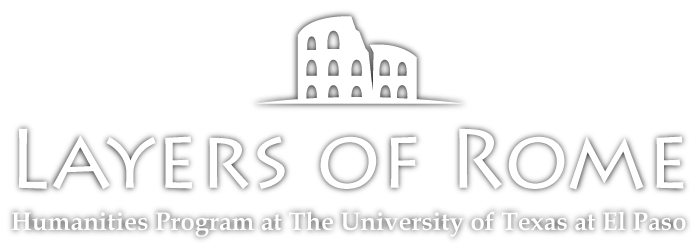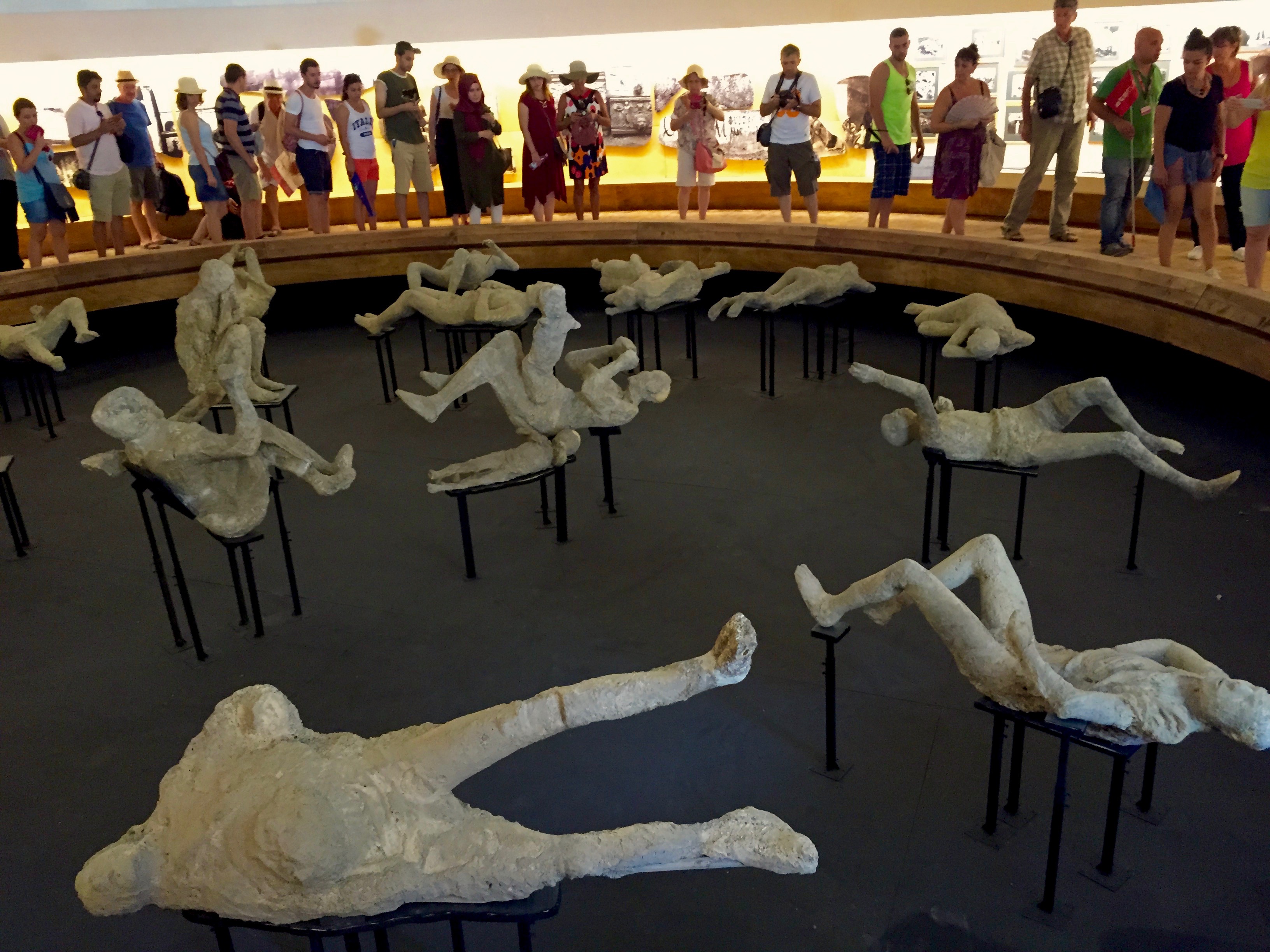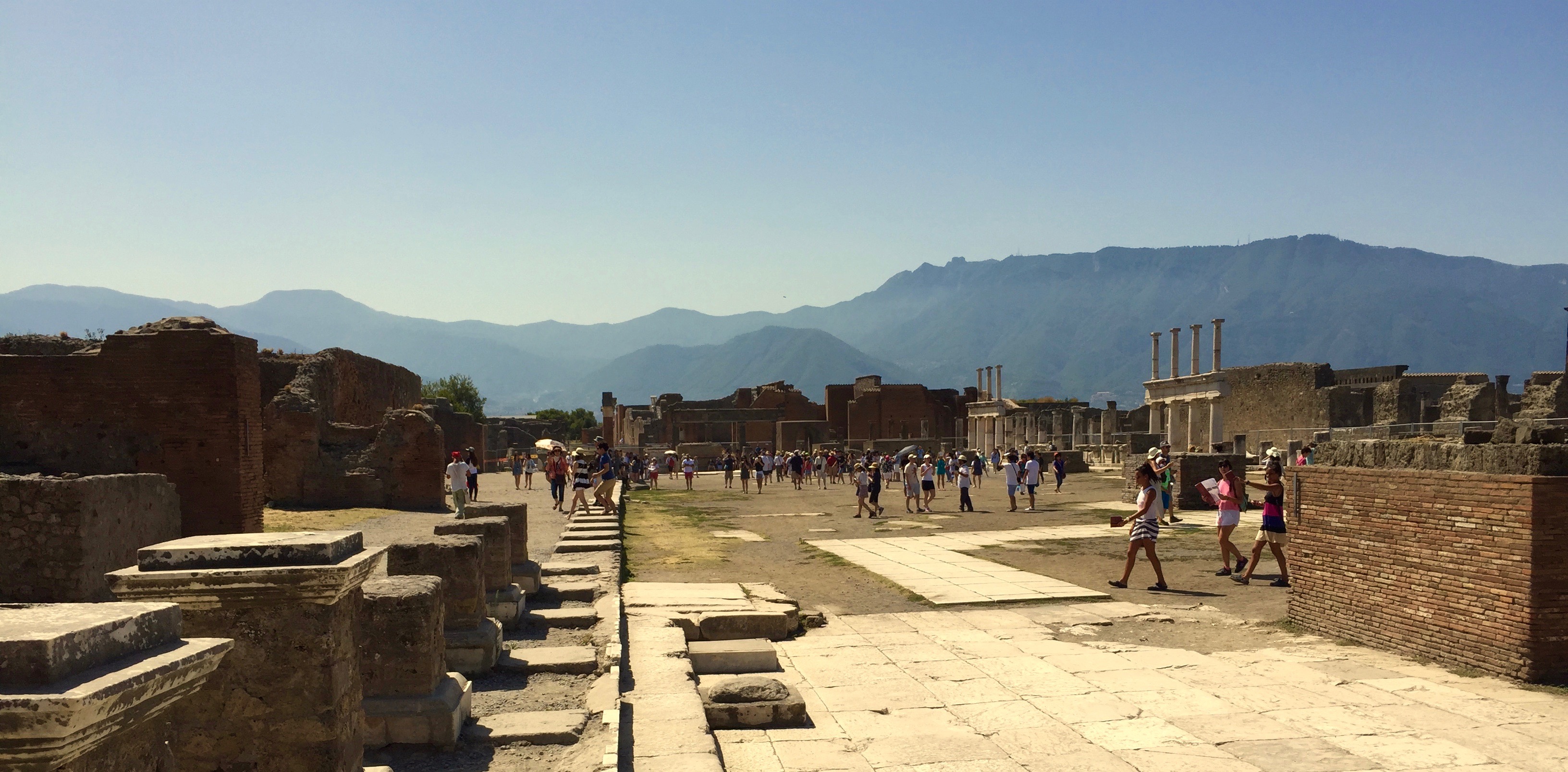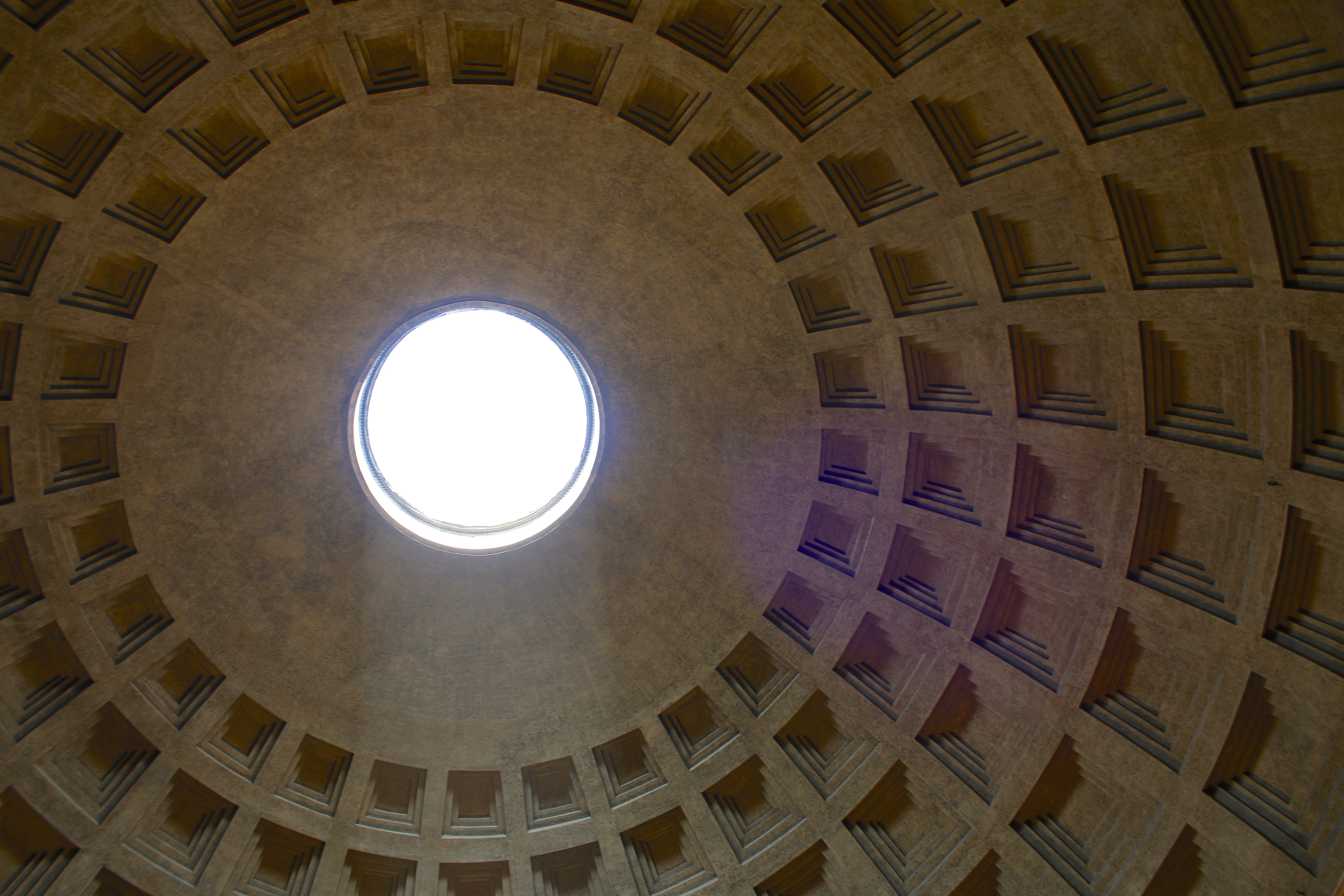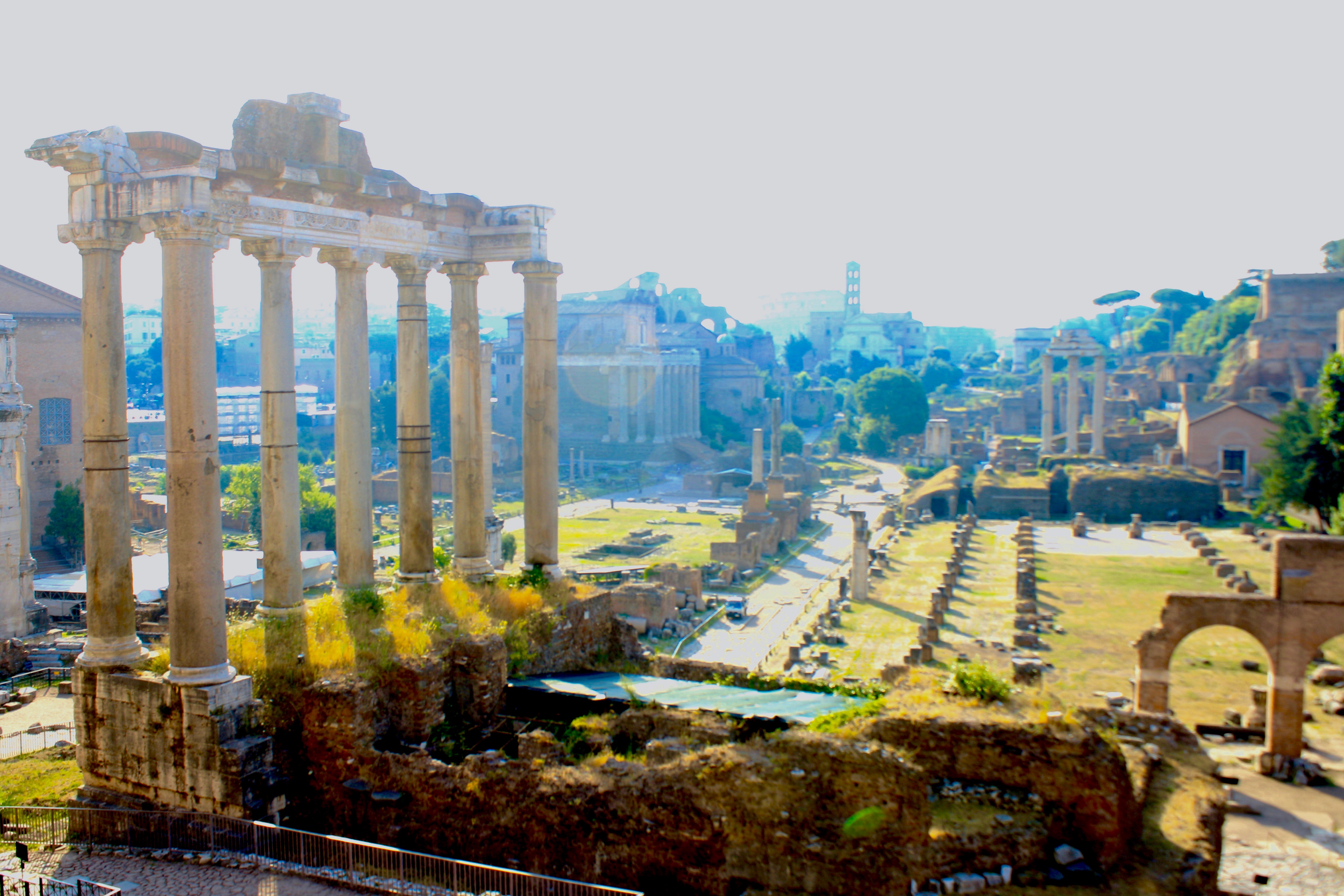Grade Levels: 3-6
Time Required: 5-7 Class Periods
Author(s): Lori Howell, Melody Nishinaga, Sarah Poku, Warren Soper
Subject Areas: Social Sciences, English, History
“A typical day in this town means going shopping, stopping by the laundry, catching a sporting event at the amphitheater, or maybe taking in a play – and that was 2000 years ago.
Can you guess where you are? Not where you might expect: You’re in ancient Pompeii, an Italian village where life came to a fiery halt when Mt. Vesuvius erupted in AD 79. “
-Discover Kids Pompeii Magazine
The eruption of Vesuvius on August 24, 79 A.D. froze a moment in time under thick layers of ash and molten mud. It preserved elements of Roman culture that demonstrate the remarkable continuity of human life and history, proving that life in the past, even the far distant past, was remarkably similar to our own. In this lesson, by taking a closer look at the remains of Pompeii, students will gain a broad appreciation of people in the past. They will study Roman culture by locating Pompeii on a map, identifying important elements of its geography, and examining the remains of Pompeii to explain how the Ancient Romans in Pompeii are similar to people today.
The Romans laid the foundations for our modern institutions of law and republican government. Their practices of learning and scholarship recorded some of the earliest examples of human progress in engineering and science. For example, the younger Pliny, nephew of the great polymath, Pliny the Elder, recorded one of the earliest eye witness accounts of a volcanic eruption, the massive explosion of Mt. Vesuvius on August 24, 79 A.D. Even though he was more than twenty miles from Vesuvius, Pliny’s experience (http://www.eyewitnesstohistory.com/pompeii.htm) demonstrates the terror of those people fleeing this massive natural disaster. In turn, the grisly plaster casts, created from the cavities left in the volcanic debris by the unfortunates who could not escape, record the fates of those living in the city at the time. It all reminds us of our own feelings of fear and hopelessness when caught in situations we do not understand and cannot control.
Moreover, Pompeii is one of the most important sources of information about Roman life. It is also the place where the continuity of history is clearest and the similarities in daily life between the Romans and modern times are the most evident. Unlike Rome, Pompeii was not an administrative or government center. As result, the largest number of remaining structures are commercial and residential. In many cases they are the same buildings with business and work space on the first floor and residences above. Therefore, the surviving architecture in the city reflects the regular, daily needs of the population. Houses contain bedrooms, dining rooms and toilets. Food being prepared at the time the eruption began was left sitting on the table or in the oven. Dishes and household items were left in the places they were stored. Tools lie scattered about the workshops.
Activities in this lesson will provide students with the opportunity to compare the spaces and artifacts found in Pompeii with the modern spaces and objects of daily life.
*Who were the Romans and where did they live?
*How do we know about the Romans who lived in Pompeii?
*Why do we study ancient Rome?
*How are we similar to the Romans?
1. Students will use methods of social science investigations to answer questions about society.
2. Students will use knowledge of the past to construct meaningful understanding of our diverse cultural heritage.
3. Students will know and apply grade-level word analysis in decoding words.
4. Students will be able to read with sufficient accuracy and fluency to support comprehension.
5. Students will conduct short research projects that build knowledge about a topic.
6. Students will write an expository text or poem to convey the similarities between Romans and us.
1. Download Lesson Overview (http://layersofrome.utep.edu/images/Updated_Lesson_Overview_Continuity_of_Culture.pdf)
2. Assemble Maps of Italy. We suggest using a map of Italy today, a map of the Roman Empire at its height, and a map of the area affected in AD 79 by Mt. Vesuvius. Possible resources are suggested in Additional Lessons and Resources found in this lesson plan.
3. Download and review the power point presentation Pompei Background
4. Download the eyewitness description of the eruption of Mt. Vesuvius in the letters of Pliny the Younger (http://www.eyewitnesstohistory.com/pompeii.htm).
5.Download and print the descriptions for the Do You Die or Survive in Pompeii (http://layersofrome.utep.edu/images/Nishinaga/Do-You-Die-or-Survive-in-Pompeii.pdf) exercise.
6. Assemble videos on Pompeii and Mt. Vesuvius that suit your needs. See suggestions in the section of Additional Lessons and Resources.
7. Upload "Then and Now" shots from Pompeii and Italy. Optional: For the “Now” photos, take pictures in your local community for comparison to Pompeii. A duplicate .pdf file can be found at: http://layersofrome.utep.edu/images/Nishinaga/Pompeii-Then-&-Now-2.pdf
8. Collect a wide assortment and/or levels of books for children to read independently or together. Additionally, research encyclopedias, magazine articles, and books that work well for your classroom research on Pompeii. See suggestions in the section of Additional Lessons and Resources.
9. Choose a graphic organizer that would be most appropriate for your classroom to identify the main ideas and details. Here are two websites with graphic organizers:
http://www.havefunteaching.com/worksheets/reading-worksheets/main-idea-worksheets
http://teacher.scholastic.com/reading/bestpractices/vocabulary/pdf/sr_allgo.pdf
Lesson One: Show and discuss maps of Italy. What does Italy look like today? What about during the time of the Roman Empire? What areas were affected by the eruption of Mt. Vesuvius in AD 79?
Lesson Two: Show and discuss the power point presentation Pompeii Background including video clips illustrating the eruption of Mt. Vesuvius and its effect on Pompeii. While discussing the presentation include the exercise Do you Die or Survive in Pompeii. A duplicate .pdf file can be found at (http://layersofrome.utep.edu/images/Nishinaga/Pompeii-Background-Presentation.pdf)
Lesson Three: Read and interpret Pliny’s two letters on Pompeii. Discuss the nature and use of primary sources with your class using the power point presentation Pliny Primary Source. A duplicate .pdf file can be found at (http://layersofrome.utep.edu/images/Nishinaga/Pliny-Primary-Source.pdf)
Lesson Four: Show power point presentation of Then and Now pictures. For example: Show the amphitheater at Pompeii and then a picture of your local football stadium. Continue through as many examples as you need for your grade level. A duplicate .pdf file can be found at (http://layersofrome.utep.edu/images/Nishinaga/Pompeii-Then-&-Now-2.pdf).
Lesson Five: (Extending over a few weeks) Students read a wide selection of non-fiction on Pompeii, such as encyclopedias for children and children’s magazines. In addition, students read historical fiction books about Pompeii. They record the similarities between the two cultures as they are reading. It is the focus of the reading.
Lesson Six: As a class, construct a graphic organizer highlighting the similarities between our world and Pompeii. For examples of a graphic organizer see # 9 in Preparation Instructions in this lesson plan. Note: Depending on the age level, this graphic organizer could be simple or complex. It could be used for a single expository text paragraph, a multi-paragraph paper, or a poem.
Lesson Seven: Using the power point presentation Writing Exercise model writing about similarities in modern writing for your class. A duplicate .pdf file can be found at (http://layersofrome.utep.edu/images/Nishinaga/Writing-Exercise.pdf).
(Extending over a few days) Students write and revise papers or poems on similarities. Note: Young children would draw pictures identifying the similarities.
Complete a Venn diagram to compare and contrast Pompeian citizens and citizens today.
Continue the study of Roman culture with the lesson “Detective Work: What Did Music Sound Like in Ancient Rome?”
Listen to the musical recreations of Synaulia, a team of musician archaeologists who recreate ancient Etruscan and Roman music. Find similar forms of modern music (https://www.youtube.com/watch?v=AKhomMCXCGs)
Review and discuss the modern rediscovery of the site and artifacts of Pompeii by studying the power point presentation on William Hamilton. A duplicate .pdf file can be cound at http://layersofrome.utep.edu/images/Nishinaga/William-Hamilton-Presentation.pdf
Reading:
CCSS.ELA-Literacy.RI.3-6
Determine the meaning of general academic and domain-specific words or phrases in a text relevant to a grade 3-6 topic or subject area.
CCSS.ELA-Literacy.RI.3-6
Interpret information presented visually, orally, or quantitatively (e.g., in charts, graphs, diagrams, time lines, animations, or interactive elements on Web pages) and explain how the information contributes to an understanding of the text in which it appears.
CCSS.ELA-Literacy.RI.3-6
Read and comprehend informational texts, including history/social studies, science, and technical texts, in the grades 3-6 text complexity band proficiently, with scaffolding as needed at the high end of the range.
Writing:
CCSS.ELA-Literacy.W.3-6
Write informative/explanatory texts to examine a topic and convey ideas, concepts, and information through the selection, organization, and analysis of relevant content.
CCSS.ELA-Literacy.W.3-6
Conduct short research projects to answer a question, drawing on several sources and refocusing the inquiry when appropriate.
Download: Lesson Plan (http://layersofrome.utep.edu/images/Updated_Lesson_Overview_Continuity_of_Culture.pdf)
Maps:
Historic Maps of Italy from Perry Castenada at UTexas: www.lib.utexas.edu/maps/italy.html
University of North Carolina maps of Italy (good for coloring): http://awmc.unc.edu/wordpress/free-maps/italy-and-sicily/
Map of modern day Italy: https://www.infoplease.com/atlas/italy
Map of Italy in the context of the world: http://www.justmaps.org/maps/images/italy/italy-map01.gif
Map of Italy in the height of the Roman Empire: https://i.pinimg.com/originals/b6/84/8d/b6848d9b954e62edbb23fd432e30419e.jpg
Google images and maps of Vesuvius and Pompeii: https://www.google.com/search?q=map+of+mt+vesuvius+and+pompeii&tbm=isch&tbo=u&source=univ&sa=X&ved=0ahUKEwirq7eKtpHXAhVKhlQKHe50DKAQsAQIJw&biw=1600&bih=854
Videos:
Pompeii Deconstructed: https://www.youtube.com/watch?v=ui4-1rNzJ1o
A Day in Pompeii (full length animation): https://www.youtube.com/watch?v=dY_3ggKg0Bc
Recreations of ancient music by the group Synaulia: https://www.youtube.com/watch?v=AKhomMCXCGs
Encyclopedia Articles:
Britannica Kids – Pompeii: http://kids.britannica.com/comptons/article- 9276498/Pompeii
Roaming the Empire – Vesuvius Blows its Top http://www.worldbookonline.com/student/assets/student-asset/surf/ancient/roman/vesuvius/html/saarfv01.htm
World Book Kids – Pompeii: https://www.worldbookonline.com/wb/Login?ed=wb&tu=https%3A%2F%2Fwww.worldbookonline.com%2Fkids%2Fhome (Subscription required)
Books on Archaeology
Duke, Kate. Archaeologists Dig for Clues. New York: HarperCollins, 1997. Print. ISBN-13: 978-0064451758
Books on Pompeii
Boyce, Natalie Pope, and Mary Pope Osborne. Magic Tree House Research Guide: Ancient Rome and Pompeii. New York, NY: Random House, 2006. Print. ISBN-13: 978-0375832208
Kunhardt, Edith Davis. Pompeii: Buried Alive. New York: Random House, 1987. Print. ISBN-13: 978-0394888668
Osbourne, Mary Pope. Magic Tree House: Vacation Under the Volcano #13. New York: Random House, 1998. Print. ISBN-13: 978-0679890508
O'Connor, Jim. What Was Pompeii? New York: Grosset & Dunlap, 2014. Print. ISBN-13: 978-0448479071
Stamper, Judith. The Magic School Bus Science Book #15; Voyage to the Volcano. New York: Scholastic, 2003. Print. ISBN-13: 978-0439429351
Tarshis, Lauren. I Survived the Destruction of Pompeii, AD 77. New York: Scholastic, 2014. Print. ISBN-13: 978-0545459396
Books about Rome
Daynes, Katie. See inside Ancient Rome. London: Usborne, 2006. Print. ISBN-13: 978074607003-1
Dickins, Rosie. The Story of Rome. London: Usborne, 2007. Print. ISBN-13: 978-0-7460-8094-8
Mancini, Andrea, and Sandra Rosi. Rome, Playing with Art. Warsaw: Mandragora, 2010. ISBN-13: 978-8874610686 (WARNING: Some pictures may be objectionable in certain communities!)
Mason, Conrad. Look Inside a Roman Town. London: Usborne, 2013. Print. ISBN: 978-1-4095-5162-1
Miles, Kelly. 100 facts on Ancient Rome. New York: Sandy Creek, 2013. Print. ISBN-13: 978-1435150836
Sasek, Miroslav. This Is Rome. New York: Universe, Print. ISBN-13: 978-0789315496
Tavormina, Maurilio. Ancient Rome: A Past & Present Trip with Cicero the Cat; A Comic Strip. Rome: Vision S.R.I., 2009. Print. ISBN-13: 6-200000-001838
Magazine Articles
Calliope Magazine - Cities of the Past http://shop.cricketmedia.com/cities-of-the-past.html
Cricket Magazine - Dog of Pompeii Pt.1 http://shop.cricketmedia.com/cricket/cricket-february-2011-issue.html
Cricket Magazine - Dog of Pompeii Pt.2 http://shop.cricketmedia.com/cricket/cricket-march-2011-issue.html
Dig Magazine - Pompeii: http://shop.cricketmedia.com/pompeii.html
Dig Magazine - The Scoop on Poop, Ingenious Plumbing on Pompeii http://shop.cricketmedia.com/poop-scoop-on.html
Kids Discover - Pompeii: http://www.kidsdiscover.com/shop/issues/pompeii-for-kids/
Primary Source
Pliny’s two letters on Pompeii: http://www.eyewitnesstohistory.com/pompeii.htm
